This page is an automated translation of /nl/sintmaarten.html and is awaiting a manual review.
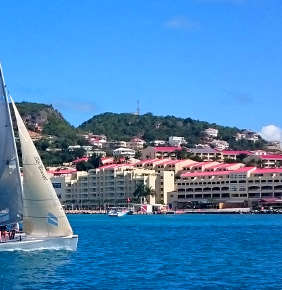
Sint Maarten is a part of the Netherlands, we have always been taught that at school. We expected to come back a little "home", but nothing could be further from the truth! Sint Maarten has hardly anything to do with the Netherlands: the official language is American, the currency used is the American dollar, the cars are American, and the entire street scene also feels very American.
The tourists here are not cruisers or other adventurers, but "ordinary" boring holidaymakers, who do nothing adventurous but sit on the beach with a beer during the day and go to one of the countless casinos or night clubs in the evening. They are either pure white (if they have just arrived) or as red as a lobster (when they return home a week later), or red with white spots (if they have a two-week vacation). Part of the harbor is reserved for luxury superyachts, where pop stars, movie stars, and I know a lot more about stars, are probably on holiday. But that part of the harbor is tightly guarded and you don't get in as a simple cruiser (although you can just race your dinghy along the mega yachts, now we suddenly understand why dinghy-wa insurance must cover such a high amount !). In one country we are at the top with our luxury sailing yacht and we feel embarrassed because we are so rich, here we are at the very bottom of the ladder with our simple sailing boat.
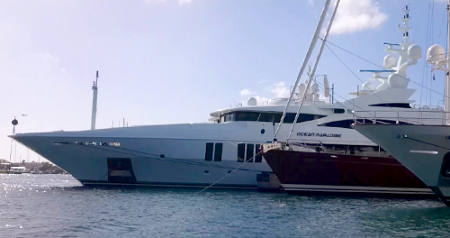
You don't go to Sint Maarten for nature, although here too sea turtles swim around the boat. But in Sint Maarten they don't have such a "nature culture"; Sint Maarten is an entertainment resort and tax haven. And for the latter we are here, because we need some stuff and we can get it the most cheaply here. Not only because of our own tax advantage, but also because the larger suppliers all have their headquarters in Sint Maarten due to the same favorable tax conditions and from here they can therefore deliver directly from the warehouse. And that is discount on top of discount. Sint Maarten is a consumer paradise, certainly compared to the rest of the Caribbean. Everything is available here and everything is possible. And that is evident from the famous airport here, where you can almost touch the incoming planes on the beach and you can have yourself sandblasted ten meters from a starting Boeing 747. And it is also evident from the fact that anyone here can start a bus company, which means that every minute a bus passes by, most of which are empty. The competition is high and they just adjust the route if you want to go to a different destination than the sign behind the windscreen indicates: just pop another sign behind the windscreen!
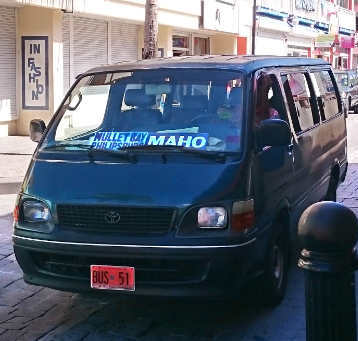
The major nautical center here is the Simpson lagoon, a kind of inland lake within which all ports and companies are located. The access from the sea is via a small channel that also has an obstacle, namely a bridge that must be opened to allow sailing boats to pass! And there is a traffic jam around opening hours, both on the road and on the water. For us, ocean sailors with no experience other than the ocean, so spacious water in the broadest sense of the word, the combination of narrow canal and bridge plus a traffic jam of ships is something completely new. But we will stay in the outer bay for the time being, because that has the great advantage that we can splash into the water from the boat, something that does not look particularly attractive from the other side of the canal. And we can leave whenever we want and we are not bound by bridge opening times, because that is a concept that we also have to get used to.
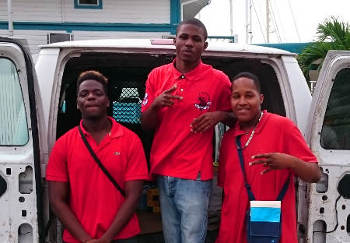
We pick up our new dinghy plus outboard engine, and a little later we tear through Simpson Bay. Each company has its own jetty here; the water sports shops, the bakery, the restaurants, etc. Strangely enough there is no "general" jetty to go deeper into the city, so you have to ignore the sign "only for customers" or the term "customer" at one of the companies. widen a bit. It's a water world here, daily we race under the bridge with our dinghy to get bread, to shop, and at the end of the day to go to Lagoonies "happy hour", to get a rum punch and socialize with the other cruisers. We race, because everything is possible here: the water police let everything race around because well, it could just as well be a millionaire's son tearing around in his inflatable boat and you don't want to bother him. So we race through the superyachts, even with the bridge open and the superyachts in procession passing the bridge.
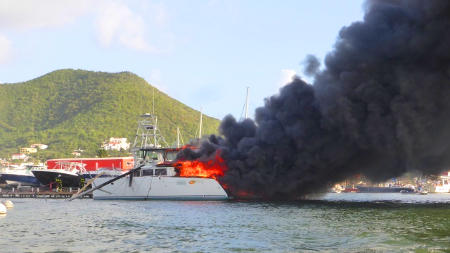
On one of the days when I do some shopping I see smoke rising somewhere near a moored boat on the way back. Is someone out there welding or something? I sail back a bit to have a good look and see that it is very wrong. Flames are now rising from a boat and the fire is spreading at an insane rate. A few bangs from exploding gas bottles and a little later the two boats that lie next to the burning boat are also on fire. Sirens roar in the city but it is rush hour so they are in a traffic jam. Once arrived, it turns out that no fire engine has a hose that is long enough. The fire rages on, a couple of neighboring boats are thrown loose and float out of control in the lagoon, as is a burning dinghy. Choking smoke from burning fiberglass now blows through the anchored boats. There is now also a catamaran on fire, all mooring lines but one burning through, and with horror the public understands that when the last mooring has also burned out, this burning island will be taken away by the wind and somewhere on another jetty a new fire will establish. Fortunately, the mast falls over before that because the mast now holds the boat in place like an anchor. It is incomprehensible that in such a busy and expensive port there is no fire boat or its own fire brigade. Only an hour later a pilot boat appears on which they have put a pump on, but it does not make much sense. The catamaran is sinking and the other two boats are completely burned out. Fortunately, all this took place at the end of a pier with the wind towards open water, otherwise the entire pier would have gone up in flames. For us it is a confirmation that mooring in a port has its risks, so we continue to anchor.
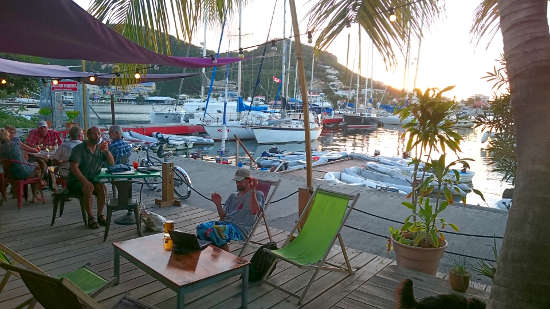
On Sint Maarten we very coincidentally meet all the cruisers that left the Netherlands the previous season and are still hanging around in the Caribbean: we have a nice drink with the Antares, de Verleiding, Kind of Blue, Gipsy Blues and some boats. We actually think St. Maarten is stupid, but the socializing is fun and we enjoy the special contacts we make. How normal is it in everyday life that you walk into a store, buy something, and are invited on board the same evening by the manager of the store (Island Water World in this case) for dinner? Here it seems normal, but we think it is special! The lagoonies pub with its own dinghy dock is the central meeting point, especially around happy hour when a bottle of beer costs $ 1 and a rum punch is tapped for $ 2. The dinghy jetty looks like a large parking lot, but the big advantage is that you can always squeeze your own dinghy somewhere between a few others by simply pushing the rest of the dinghies aside. At the end of the evening all dinghies leave again, very funny to see, all male-female on board, usually male at the engine and female in front. We do it the other way around because we have discovered that we then go much faster due to the more favorable weight distribution.
Our new dinghy tears over the water, which sometimes contains quite considerable waves. The thing jumps over the waves and then lands with a hefty bang on the next wave. It hits your back quite a bit, but hey, what's that? I often had back pain in the Netherlands, but not since we started on the road. Higher temperatures, the constant massaging effect of the ever-moving boat, a lot of swimming and walking, all factors that prevent my back pain. Until one evening we have a drink with others on the boat and my back is just in the draft. Well, there is still a draft ... still close to 30 degrees Celsius, so I ignore it completely. The next day I am presented with the bill with a stiff and sore back. I can't do much for a day, just before we want to leave for the island of Saba. The next morning my back feels better again and we leave for Saba anyway. We still have to hoist the dinghy and outboard on board, refuel and so on (so finally for the first time in our sailing career under a bridge) but these physical activities are not doing my back any good. At the next bridge opening we sail out again, on our way to Saba.
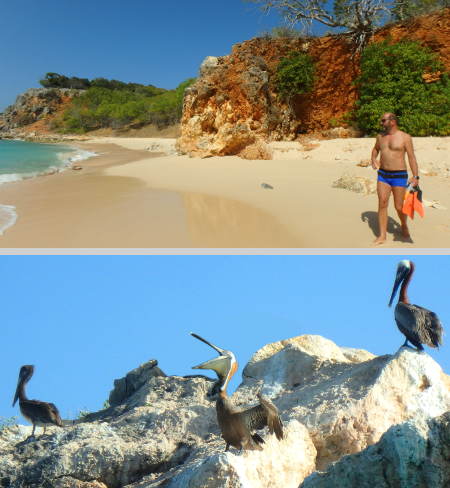
After Saba, on which we wrote a separate report, we will return to Sint Maarten for a while because our new sail will be delivered here. We do a small expedition around St. Maarten, we sail to Titamarre and a nature reserve near Anguilla. Officially we should also clear in and out there, but since we only stay one night everywhere, we believe it. Tintamarre is a beautiful little uninhabited nature island about 15 nm from Simpson bay. You can snorkel here and there are many pelicans. Prickly Pears Cays is an archipelago that belongs to Anguilla. It contains a few beautiful islands and a few reefs. It is very beautiful but it is really a big disadvantage that you are not allowed to stay overnight. In practice, this means that you arrive a little before noon and have to leave around four, unless you want to sail in the dark.
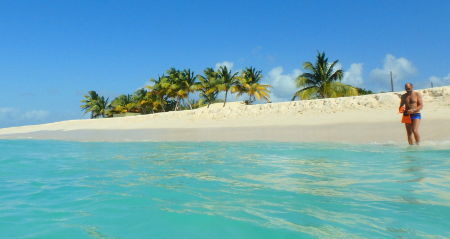
After customs clearance in Saba, a week has now passed and we wonder whether the authorities do not think it strange at the next clearance that we took a week to sail from Saba to Sint Maarten. Then suddenly we are overtaken by a boat from the coastguard who wants to board us. A few seconds later, the small cockpit is packed with three extra passengers; two men and a woman in uniform with steel-toed boots and a bulletproof vest (and no, they didn't take off their shoes!). It turns out to be just a routine check and they want to know everything. Whether we have life jackets. And oh yes, whether we can also show the "flares", ie emergency fire levels. However, I don't feel like it because I know that the expiration date has now expired. This kind of fireworks is now really outdated, especially now that we have AIS with alarm function, an epirb (floating emergency beacon that automatically sends an SOS plus our position to the satellite), etc. So we say that this is no longer mandatory in the Netherlands, because it is outdated and that fireworks themselves are a "safety hazard". For ships, you must comply with the rules of the country under whose flag you sail, so we must comply with the Dutch rules. The coastguard accepts and disembarks a little later: everything is fine!
We install our new roller-furling jib with the help of Hedda van de Antares, and a day later we say goodbye to Sint Maarten. We have been here for too long and now really need to go to the Panama Canal if we want to be in the Pacific in time. We doubt whether we will not sail directly there, but all experts say that we should definitely visit Bonaire. No sooner said than done, so we now sail towards Bonaire.